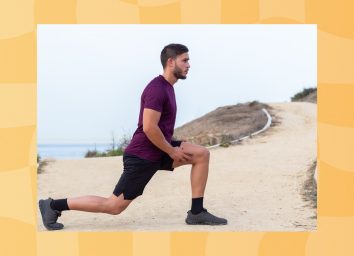Avoid These Exercises if You Want to Lower Your Blood Pressure

As our friends at ETNT Health have reported, deaths attributed to high blood pressure, otherwise known as hypertension—when the pressure in your blood vessels is too high—were up a staggering 11% in 2020. Blood pressure-related deaths outnumber deaths attributed to the flu, pneumonia, heart disease, and stroke. Having high blood pressure will put your body at risk of several dangerous side effects that include aneurysm, heart attack, kidney issues, dementia, metabolic syndrome, and—yes—early death.
Several lifestyle changes can help you lower your blood pressure, such as getting a full night's rest, watching your sodium intake, and cutting down booze. But one of the best ways to get your blood pressure back down to healthy levels is to exercise.
According to a new study published in the American Journal of Preventative Medicine, if you're looking to maximize your heart health and keep your blood pressure low well into old age, you should be doing at least 5 hours (or 300 minutes) of moderate-intensity exercise every single week. If that sounds like a lot, it is. After all, the latest guidelines from the U.S. Department of Health and Human Services advise adults to aspire to perform at least 150 minutes to 300 minutes of moderate-intensity exercise every week to enjoy the health benefits of working out.
In any case, if you're looking to lower your blood pressure, it's helpful to know that not every exercise is actually created equal—regardless of how long you do it. Some are great, some aren't so great. Read on to know which ones are right for you. And for more great workouts you may wish to try, see here for The Secret Exercise Trick for Flatter Abs After 40.
The Good Exercises for Lowering Blood Pressure

According to the health experts at the charity Blood Pressure UK, the best exercises for lowering your blood pressure are aerobic exercises such as cycling, brisk walking, swimming, dancing, gardening, tennis, and jogging. "Aerobic exercises are repetitive and rhythmic movements which get your heart, lungs, blood vessels and muscles working," the experts explain. "They use the large muscle groups of your body, such as those in your legs, shoulders and arms. Walking, jogging, swimming, dancing and heaving gardening, such as digging, are all aerobic activities."
But the site also notes some exercises that aren't so good at lowering your blood pressure, such as…
Bad: Sprinting, Weightlifting, and Squash

Any type of exercise that is super intense for a short period of time isn't advised, say Blood Pressure UK. "They raise your blood pressure very quickly and put too much strain on your heart and blood vessels."
The organization notes that exercises such as sprinting, weightlifting, and squash fall into this category.
"Weightlifting can cause a temporary increase in blood pressure," note the leading health experts at The Mayo Clinic. "This increase can be dramatic, depending on how much weight you lift. But, weightlifting can also have long-term benefits to blood pressure that outweigh the risk of a temporary spike for most people. You shouldn't lift weight s if your blood pressure is uncontrolled and higher than 180/110 millimeters of mercury (mm Hg)." And for more exercise advice, see here for the Secret Exercise Tricks for Keeping Your Weight Down for Good.
Also Bad: Scuba Diving and Skydiving

"Some extreme sports such as scuba diving or parachuting can be dangerous if your blood pressure is not under control," write the experts at Blood Pressure UK. "You will need a medical certificate from your doctor to start or continue doing them."
So How Much Exercise Should You Really Do?

According to The Mayo Clinic, doing roughly 30 minutes of moderate-intensity physical activity every day "can lower your blood pressure by about 5 to 8 mm Hg." According to the aforementioned study in the American Journal of Preventative Medicine, you should aspire to perform at least an hour of moderate-intensity exercise every day.
So which is it?
Well, according to a brand-new study published in the British Journal of Sports Medicine, there is a specific formula that you can apply to your own life that the researchers say will be much more accurate for you.
It works like this: Simply perform 3 minutes of "moderate-to-vigorous" exercise for every hour you sit every day. (If you can't do more vigorous exercises, you can get by with "12 minutes of light physical activity" every hour.) You don't have to exercise 3 minutes every hour—but add it up. If you sit for 7 hours every day, you should be performing at least 21 minutes of moderate-to-vigorous exercise—such as brisk walking—every day. According to the researchers, this could extend your life by 30%. And for more ways to add years to your life, don't miss The Secret Way Sitting Can Extend Your Life, Say Experts.








